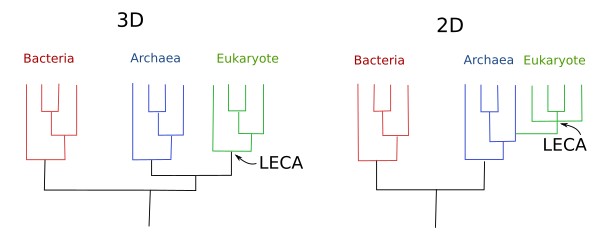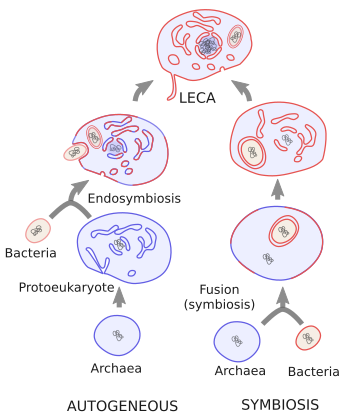Prokaryote were the first cells to appear on Earth, which happened about 3500x106 years ago. Prokaryote means before the nucleus, that is, they do not have DNA enclosed by an inner membrane. The organization of prokaryotic cells is quite simple: a plasma membrane confines an inner space where chemical reactions take place. They also show a capsule lining the extracellular surface of the plasma membrane, and structures such as prokarytoe flagella and pili, for cell movement and DNA exchange, respectively, can sometimes be observed. Prokaryotes were thought to be the only cell type during the first 1500 - 2000x106 year of the early Earth. Two main groups of prokaryotes are known: bacteria and archaea.
The eukaryote cell is regarded as an evolutionary transition. It was something new, with novel features that allow it to explore new evolutionary pathways. The eukaryote cells reached a morphological complexity level not seen before, the nucleus included, and developed a network of fibrous proteins known as cytoskeleton. They were also able to integrate whole genomes (that gave rise to mitochondria and chloroplasts), developed the sexual reproduction, and led to a new type of living beings: the multicellular organisms (which independently happened several times).
1. When?
Eukaryotic cells appeared 1500-2000x106 years ago. It is about 1500x106 after the prokaryotes. It means that the process of eukaryogenesis should have being started much earlier, may in the prokaryote communities that populated the Earth at that time.
2. From who?
It is not known how did eukaryotes emerge, but it should have happened as a result of the collaboration between the two prokaryotic cell types present at that time: archaea and bacteria. Eukaryotes are thought to be monophyletic, which means that all of them, including plants, animals, fungi, algae, and unicellular eukaryotes, descended from a common ancestor known as LECA (Last Eukaryotic Common Ancestor). So, with the evidences we have today, the eukaryote cell was "invented" only once during evolution. Comparison of genomes of today's phylogenetically distant eukaryotes suggests that LECA already had a genome as complex and rich as the genome of the current cells, and probably with similar cellular morphology and structure.
There is no doubt that LECA evolved from prokaryotes, but from which one, bacteria or archaea? Choosing one of them is not easy. Current eukaryotes are like chimeras because genes from both types of prokaryotes coexist in the eukaryotic nucleus. For example, genes involved in DNA processing, including replication, transcription and translation are more similar to those of archaea, while those genes in charge of the metabolism, such as energy production and synthesis of amino acids, lipids and nucleotides, are more similar to the genes of bacteria. However, not all genes follow these rules. To make things more complex, the archaea genes in the eukaryote nucleus come from different archaea taxa.
Recent evidences from genome phylogenetic studies place the origin of eukaryotes closer to archaea than to bacteria (Figure 1). Let see why.

Phylogenetic studies (comparison of DNA sequences) suggest that eukaryotes emerged from a recently discovered group of archaea named the Asgard group. These evidences support the 2D hypothesis (Figure 1). This group includes the lokiarchaea, which have been found to be the prokaryotes most closely related to eukaryotes when comparing informational genes. Informational genes are supposed to be much less mutated during evolution, such as those involved in DNA processing. Furthermore, some authors suggest that these genes are primarily transmitted through generations of descendants rather than horizontally (between non-related cells). That is why these genes are good tools for establishing more accurate evolutionary relationships between organisms. Lokiarchaeota and other Asgard archaea contain genes related to cytoskeleton, vesicular trafficking, inner membrane organization, and DNA repairing, that were though to be only present in eukaryotes, and had not being found in any other prokaryote.
No lokiarchaea has been seen yet. They were discovered by metagenomic studies, which are genomic studies of environmental samples. Thus, water was collected near to a hydrothermal vent, the DNA was purified and sequenced. With bioinformatic tools, genomes were assembled from the DNA fragments, and it was found that some genomes were new and do not belong to any known prokaryote. After further gene analyzing, these genomes were phylogenetically placed in a new archaea branch named Asgard. They contain genes to survive in anoxic environments. After comparing Asgard and eukaryote genomes, many homologous genes were found. Then, it was posed that LECA emerged from this new archaea branch, initially lived in anoxic environments, and could move to more oxygenated places after the endosymbiotic process with an alfa-proteobacteria (the current mitochondria). Since, not many Asgard prokaryotes have been cultured yet, it is difficult to make morphological studies.
However, there are 2 to 3 times more genes from bacteria than from archaea in the eukaryotic nucleus, . These genes appear to come from different lineages such as cyanobacteria, actinobacteria, proteobacteria, and others. Furthermore, eukaryotic membranes do not contain isoprenoid chains or ether linkages in membrane their membrane lipids, both of which are typically found in archaea membranes. In fact, it can be said that eukaryotes have membranes more similar to those of bacteria. There are many other genes from bacteria that were thought to perform relevant roles during eukaryogenesis. This information has to be integrated in the evolutionary studies of eukaryotic cells.
3. How? Eukaryogenesis
There is a key event during the emergence of LECA: what was the impact of the endosymbiosis of the mitochondrial ancestor? Some authors claim that this event was essential for cells to become LECA, whereas others propose that cell engulfing the mitochondrial ancestor already had a complex genome and well-developed cell structure. Therefore, the first endosymbiosis was just one more step towards becoming LECA (Figure 2). There are many theories about how the evolutionary process that gave rise to LECA happened. They can be summarized in two:

Eocyte or autogenous model . It suggests that an arcahea lineage progressively increased the cellular complexity to develop into the first eukaryotic common ancestor (FECA), and then into LECA. It means that a proto-eukaryote cell (FECA) was first developed, which emerged from the Asgard archaea lineage. These cells independently acquired most of the cell complexities found in the eukaryote cells, such as the endomembrane system and the cytoskeleton, but lack mitochondria. They also got the ability to do phagocytosis, that later allow them to acquire an ancestral alfa-proteobacterium. The phagocytosed prokaryote was not digested, ended up living as an endosybiont, and become the mitochondria. This model is getting experimental support as new analyzed archaea genomes show that genes for membrane trafficking and cytoskeleton proteins are already present in the Asgard group. Therefore, a progressive development is plausible. The gene complexity could be reached with genome, or gene, duplications, and with gene horizontal transfer coming from other prokaryote lineages. There are evidences that gene duplication rate increased after the endosymbiotic event. However, a question not yet answered by this model is why intermediate cell forms between FECA and LECA, that is, eukaryote cells without mitochondria, have not been found.
Symbiotic model. This model proposes that the direct fusion of a archaea and a bacterium gave rise to the first eukaryotic cell. There was no proto-eukaryote intermediate stage between prokaryote and eukaryote. In the phylogenetic tree there would be two initial branches, archaea and bacteria, and then a third branch, the eukaryote. There are current examples of bacteria cells with prokaryote cell inside. The fusion of the two cell triggered the increase in cell complexity, and the bacteria became the mitochondria. In this new cells, archaea rules the DNA processing and bacterium the metabolism and membranes. Some authors suggest that the archaea-bacteria relationship begun much earlier than the final fusion. Therefore, it was a long-time process. First there was a symbiosis between the two cells, and a transfer of genes from the bacteria to the archaea genome, which favor a physical proximity. This symbiosis may have involved the hydrogen production by the bacteria, which was used by the archaea. In turn, the archaea provided organic molecules to the bacteria. At the end, the bacteria moved and lived within the archaea, which already expressed many bacteria genes. It is not known how were the cellular mechanisms. It is suggested that it was by phagocytosis, but there is no experimental support.
4. Endomembranes
One feature of eukaryotes, different from prokaryotes, is a rich and complex endomembrane system. The evolutionary origin of this system is still unknown. All the inner membrane-bound compartments may have been formed from archaea plasma membrane invaginations that were later detached. Thus, the interior of the endoplasmic reticulum or the Golgi apparatus is actually extracellular space. However, how the archaea lipids (isoprenoid fatty acid chains and ether bonds) were replaced by the bacteria lipids (no isoprenoids and with ester bonds) remains to be revealed.
Current prokaryotes do not form inner vesicles, and do not perform endocytosis, although they can invaginate the plasma membrane and generate inner cisterns, which remain connected with the plasma membrane. However, both archaea and bacteria are able to shed vesicles to the environment, that is, extracellular vesicles. It is interesting that current mitochondria can produce vesicles, known as mitochondrial derived vesicles, that are released into the cytoplasma.
As it was mentioned above, the finding of proteins involved in vesicular trafficking, membrane organization, and cytoskeleton in some archaea groups suggests that a complex organization may be present in some archaea lineages, but it remains to be found.
What did happen with the ATP production system of the ancestor archaea? Prokaryote cells are able to produce ATP in their plasma membranes thanks to the ATPase activity. Once the bacterium (the mitochondrial ancestor) was inside the archaea cell, and having its own ATPase, which was more efficient, the archaea ATPase was moved to the endosomal-lisosomal compartment, and become a proton pump to decrease the lysosomal pH. For that, it has to do the opposite function: consuming ATP to generate a proton gradient. This change allowed the intracellular digestion of lysosomes.
-
Bibliografía ↷
-
Bibliografía
Archivald, JM. 2015. Endosymbiosis and eukaryotic cell evolution. Current biology. 25: R911-R921.
Dey G, Thattai M, Baum B. 2016. On the archaeal origins of eukaryotes and the challenges of inferring phenotype from genotype. Trends in cell biology. 26: 476-485
.
Gould SB, Garg SG, Martin WF. 2016. Bacterial vesicle secretion and the evolution- ary origin of the eukaryotic endomembrane system. Trends in microbiology. 24: 525–534.
Koonin, EV. 2010. The origin and early evolution of eukaryotes in the light of phylogenomics. Genome biology. 11: 209
.
López-García P, Moreira D. 2015. Open questions on the origin of eukaryotes. Trends in ecology and evolution. 30: 697-708
.
Martin WF, Neukirchen S, Zimorski V, Gould SB, Sousa FL. 2016. Energy for two: new archaeal lineages and the origin of mitochondria. Bioessays. 38: 850–856
.
-
 Origen of the cell
Origen of the cell 